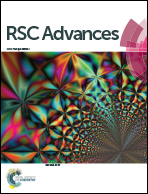Sol–gel-processed (001)-textured BiFeO3 thin films on Pt(111)/Ti/SiO2/Si substrates with PbO seeding nanocrystals
Abstract
50 to 200 nm-thick BiFeO3 thin films were fabricated on Pt(111)/Ti/SiO2/Si substrates using the sol–gel method. A PbO seeding layer was introduced between the BiFeO3 films and the platinum electrode surface, which was found to be effective for the formation of a (001)-textured BiFeO3 structure. A high degree of (001) orientation up to 98.3% was achieved in a 200 nm-thick film via a layer-by-layer annealing process. Cross-section images by scanning electron microscopy revealed a columnar crystal structure, which was consistent with the high texturing degree enhanced by the layer-by-layer annealing method. By investigating the dielectric, ferroelectric and piezoelectric properties of the randomly oriented and (001)-oriented films, it was revealed that significant enhancements of the dielectric and piezoelectric properties were achieved in textured samples. The texturing mechanism was also discussed.


 Please wait while we load your content...
Please wait while we load your content...